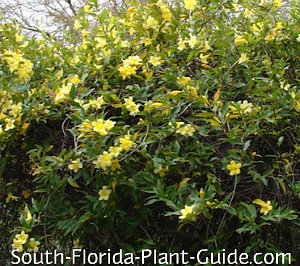
Autumn Olive forms dense shrub growth in our forests, crowding out native shrubs and wildflowers. The most common invasive species in Mecklenburg County is Autumn Olive (Elaeagnus umbellata). A living fence of Carolina Jasmine can be seen around the perimeter of the grocery store at Central Avenue and The Plaza in the Plaza Midwood neighborhood of Charlotte. From basic arbors to living fences and screen walls, Carolina Jasmine can be used in many different ways! An example of a screen wall can be seen along the Little Sugar Creek Greenway between Elizabeth Avenue and 7th Street. Its preferred environment is somewhere sunny with well-drained soil. Although it is evergreen (meaning it remains attractive year-round), bright yellow flowers bloom in early spring. Carolina Jasmine (Gelsemium sempervirens)Ī beautiful vine that twines, Carolina Jasmine can be found along roadsides and in open forest habitats throughout the County. If you’d like to see them up close, several of these shrubs can be found in the Van Landingham Glen at the UNC Charlotte Botanical Garden. They can easily be spotted by their dark-green, paired leaves and deep red flowers in spring.

Best used in a woodland garden or along a border, these shrubs prefer partial shade and moist soil. This deciduous shrub is found along moist, rich streamsides throughout the County. Sweet-Shrub, Carolina Allspice (Calycanthus floridus)

This shrub produces small, wax-coated berry-like fruits that birds love. A great place to see one in person is the entrance road to Reedy Creek Park and Nature Preserve! Wax Myrtles can grow up to 12 feet tall without any pruning, but can be kept lower and denser and can even be pruned into a small tree if desired. Though this evergreen shrub is native to eastern North Carolina, it is widely used in landscaping throughout Mecklenburg County. Once that happens, they require very little work! Wax Myrtle (Morella cerifera) As for maintenance, light watering will help the roots get established. Redbud trees are suitable in a variety of conditions, but are most often found in the understory with partial shade and well-drained soils. An easy way to recognize a redbud tree is by their flowers – they have small lavender or pink flowers that are held close to the branches, and their leaves are heart-shaped (they bloom in early spring).

Some common spots are along roadsides and in most forested areas, including our parks and nature preserves. This small native tree can be found all throughout the County. Native Plants in Mecklenburg County Redbud (Cercis canadensis) Let’s take a look at some of the native plants our Park and Recreation staff recommends using (if you stick with us until the end, we’ll also touch on some invasive species). But, part of a having a successful garden includes knowing what is and is not suitable for our environment. If there’s one thing that can brighten up a home pretty quickly, it’s adding plants to your garden. Written with assistance from Catherine Luckenbaugh of Park and Recreation


 0 kommentar(er)
0 kommentar(er)
